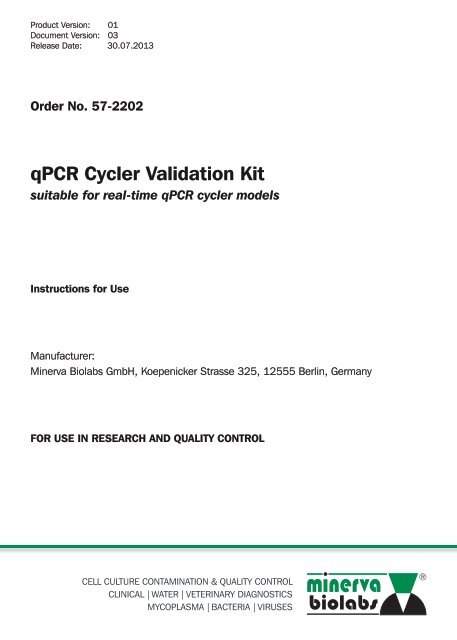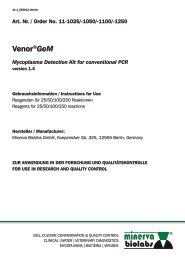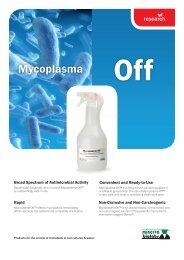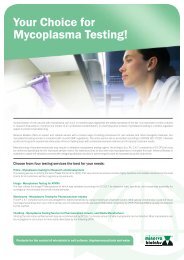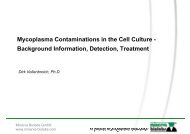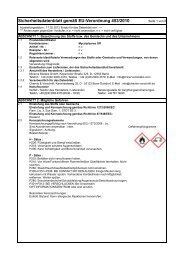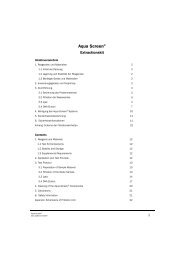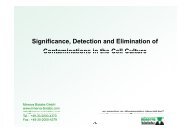Instructions for use - Minerva Biolabs
Instructions for use - Minerva Biolabs
Instructions for use - Minerva Biolabs
Create successful ePaper yourself
Turn your PDF publications into a flip-book with our unique Google optimized e-Paper software.
Product Version: 01<br />
Document Version: 03<br />
Release Date: 30.07.2013<br />
Order No. 57-2202<br />
qPCR Cycler Validation Kit<br />
suitable <strong>for</strong> real-time qPCR cycler models<br />
<strong>Instructions</strong> <strong>for</strong> Use<br />
Manufacturer:<br />
<strong>Minerva</strong> <strong>Biolabs</strong> GmbH, Koepenicker Strasse 325, 12555 Berlin, Germany<br />
FOR USE IN RESEARCH AND QUALITY CONTROL
Symbole / Symbols<br />
Chargen-Nr. / Lot No.<br />
Artikel-Nr. / Order No.<br />
Verfallsdatum / Expiry date<br />
Lagerung bei / Store at<br />
Enthält Reagenzien für 25, 50, 100 oder 250 Bestimmungen<br />
Contains reagents <strong>for</strong> 25, 50, 100 or 250 tests<br />
Hersteller / Manufacturer
INDICATION<br />
Verification of block or air-heated qPCR cyclers as part of Installation Qualification (IQ), Operational<br />
Qualification (OQ) and Per<strong>for</strong>mance Qualification (PQ) according to legal requirements, like<br />
ISO 17025, EN 45001, ISO 13485, ISO/TS 20836:2007, GLP, GMP and others.<br />
EXPLANATION OF THE TEST<br />
False negative PCR results or unspecific amplifications might be ca<strong>use</strong>d by a defect PCR cycler.<br />
Both events are highly critical <strong>for</strong> Good Laboratory Practise. Verification of the correct temperature<br />
control of the <strong>use</strong>d equipment is usually a stressful issue. To comply with quality management<br />
systems is not easy to fulfil <strong>for</strong> PCR cyclers. Electronic temperature sensors offered <strong>for</strong> purchase<br />
or as service usually measure the temperature homogeneity in a cycler block, only, which<br />
does not necessarily reflect all parameters which need to be controlled by the cycler and can fail<br />
to provide reliable PCR results. Only a reference setup can investigate all relevant parameters of<br />
the process reliably.<br />
TEST PRINCIPLE<br />
The qPCR Thermal Cycler Validation Kit provides temperature sensitive PCR reactions to verify the<br />
temperature sensor and cycler processor in a realistic run. The primer sequences in combination<br />
with a regular PCR protocol were designed to react extremely sensitive to incorrect temperature<br />
control, temperature homogeneity, precision and timing. Amplification will be altered and indicated<br />
by different Ct values and morphology of the amplification curve at temperature differences of<br />
more than 2 °C. The cycler per<strong>for</strong>mance is tested at typically <strong>use</strong>d PCR settings to reflect most<br />
<strong>use</strong>rs applications. In addition, the pre-adjusted target concentrations are only amplified at high<br />
PCR efficiencies as an additional indicator <strong>for</strong> accurate temperature control of the thermal cycler.<br />
57-2202<br />
Doc.-Version 03<br />
Last update 30.07.2013<br />
1
REAGENTS<br />
The expiry date of the unopened package is marked on the package label. The kit components<br />
are stored until <strong>use</strong> at +2 to +8 °C. The lot specific Certificate of Analysis can be downloaded<br />
from our website (www.minerva-biolabs.com).<br />
Kit Component<br />
Label In<strong>for</strong>mation<br />
Quantity<br />
Cap Color<br />
Validation Mix 4 vials, 25 reactions each, freeze-dried Red<br />
Rehydration Buffer 2 vials, 1.9 ml Blue<br />
Control 1 vial, freeze-dried Green<br />
NEEDED, BUT NOT INCLUDED IN THE KIT<br />
The qPCR Thermal Cycler Validation Kit Cat.-No. 57-2202 contains all reagents required <strong>for</strong> the<br />
validation of the cycler. General industrial supplies and reagents, usually available PCR laboratories<br />
are not included:<br />
qPCR device with filter sets <strong>for</strong> the detection of the fluorescence dyes FAM and ROX<br />
PCR reaction tubes <strong>for</strong> the specific qPCR device<br />
1.5 ml reaction tubes, DNA- and RNA-free<br />
Micro centrifuge <strong>for</strong> 1.5 ml PCR reaction tubes<br />
Pipettes with corresponding filter tips to prepare and dispense the reaction mix<br />
(10, 100 und 1000 μl)<br />
PRECAUTIONS<br />
For <strong>use</strong> in research and quality control. This kit should be <strong>use</strong>d only by trained persons. This kit<br />
does not contain hazardous substances and may be disposed of according to local regulations.<br />
TEST PROCEDURE<br />
The validation should be precisely per<strong>for</strong>med as described. All reagents and samples must be<br />
equilibrated to +2 to +8 °C prior <strong>use</strong>.<br />
1. Rehydration of the reagents<br />
1. Spin all freeze-dried components - Validation Mix (red cap) and Control (green cap) - <strong>for</strong> 5<br />
sec at maximum speed of the centrifuge.<br />
2. Add 700 μl Rehydration Buffer (blue cap) to each vial of the Validation Mix (red cap) and<br />
100 μl to the Control vial (green cap).<br />
3. Close the vials and incubate 5 min at room temperature.<br />
4. Vortex DNA briefly and spin <strong>for</strong> 5 sec.<br />
5. After reconstitution, the reagents should be stored at < -18 °C.<br />
2<br />
57-2202<br />
Doc.-Version 03<br />
Last update 30.07.2013
2. Preparation of the Reaction Tubes<br />
1. Add 25 μl to each PCR tube (e.g. as indicated by the orange-coloured positions in the<br />
diagram).<br />
2. Prepare at least 2 vials per run (e.g. as indicated by the green-coloured positions in the<br />
diagram) by adding 23 μl of the validation mix to the PCR tube. Add 2 μl of the Control<br />
(green cap).<br />
3. Close and spin all PCR tubes briefly.<br />
3. Loading the Tubes<br />
The loading scheme depends on the block <strong>for</strong>mat of the PCR cycler. The following schemes are<br />
suggestions <strong>for</strong> regular testing. If particular peltier elements, segments of the block or cavities are<br />
already subject of investigation, the strips or even individual tubes can be placed flexible within<br />
the block.<br />
96 well block:<br />
48 well block:<br />
24 well block:<br />
57-2202<br />
Doc.-Version 03<br />
Last update 30.07.2013<br />
3
4. Starting the reaction<br />
1. Load the cycler, check each PCR tube and the cycler lid <strong>for</strong> tight fit.<br />
2. Program the qPCR cycler or check stored temperature profiles.<br />
See Appendix <strong>for</strong> temperature profiles of selected qPCR cyclers. Programs <strong>for</strong> additional cyclers<br />
might be available on request.<br />
3. Start the program and data reading.<br />
5. Result reading<br />
1. Safe the data at the end of the run.<br />
2. Read the channels <strong>for</strong> the wavelengths 520 and 610 nm and show the 2nd deviation of the data.<br />
3. Read the calculation of the Ct values <strong>for</strong> all reactions.<br />
4. Evaluate in accordance with the laboratory and instrument-specific reference ranges<br />
INTERPRETATION OF RESULTS<br />
The cycler is passing the test and the results of the check are valid if signals are visible in the<br />
ROX channel and comparable in Ct value and signal strength to the control reaction. If the cycler<br />
does not comply with the expected specifications by either showing signals in both channels or<br />
no or no signal at all:<br />
Channel FAM<br />
Channel ROX<br />
Samples Control Samples Control<br />
no<br />
(Ct > 35)<br />
yes<br />
(Ct < 35)<br />
yes<br />
(Ct < 30)<br />
yes<br />
(Ct < 30)<br />
yes<br />
(Ct < 30)<br />
Result<br />
cycler ok<br />
yes yes yes temperature too low<br />
Consequence <strong>for</strong> your<br />
standard application<br />
good results<br />
PCR conditions not stringent<br />
enough; risk of false<br />
positive results<br />
no<br />
no<br />
(Ct > 35)<br />
yes yes temperature too high<br />
PCR conditions too stringent;<br />
risk of low PCR<br />
efficiency / sensitivity<br />
no no no no fatal error no results<br />
Please note, that all PCR reactions should show a uni<strong>for</strong>m result. If not, most likely one or even<br />
more of the peltier elements show a malfunction. In this case the experiment should be repeated<br />
with an adopted loading scheme.<br />
4<br />
57-2202<br />
Doc.-Version 03<br />
Last update 30.07.2013
NOTES ON THE TEST PROCEDURE<br />
1. This leaflet must be widely understood <strong>for</strong> a successful <strong>use</strong> of the qPCR Thermal Cycler Validation<br />
Kit. The reagents supplied should not be mixed with reagents from different lots and<br />
<strong>use</strong>d as an integral unit. The reagents of the kit should not be <strong>use</strong>d beyond its shelf life.<br />
2. Any deviation from the test method can affect the results.<br />
3. The <strong>use</strong> of control samples is not required as the PCR set contains a setup check.<br />
APPENDIX<br />
Limited Product Warranty<br />
This warranty limits our liability <strong>for</strong> replacement of this product. No warranties of any kind, express<br />
or implied, including, without limitation, implied warranties of merchantability or fitness <strong>for</strong><br />
a particular purpose, are provided. <strong>Minerva</strong> <strong>Biolabs</strong> shall have no liability <strong>for</strong> any direct, indirect,<br />
consequential, or incidental damages arising out of the <strong>use</strong>, the results of <strong>use</strong>, or the inability to<br />
<strong>use</strong> this product.<br />
Trademarks<br />
ABI Prism and FAM are registered trademarks of Applera Corporation.<br />
Rotor-Gene is a registered trademark of Qiagen GmbH.<br />
Mx3005P is a registered trademark of Agilent Technologies, Inc..<br />
57-2202<br />
Doc.-Version 03<br />
Last update 30.07.2013<br />
5
Programming and data recording devices of different qPCR<br />
Rotor-Gene ® 6000 (5-plex)<br />
Please check the correct settings <strong>for</strong> the filter combination:<br />
green filter (470-510): probe 1<br />
Target probe 1 probe 2<br />
orange filter (585-610): probe 2<br />
Channel green orange<br />
Program Step 1: Pre-incubation<br />
Setting<br />
Hold<br />
Hold Temperature 95 °C<br />
Hold Time<br />
3 min 0 sec<br />
Program Step 2: Amplification<br />
Setting<br />
Cycling<br />
Cycles 40<br />
Denaturation<br />
95 °C <strong>for</strong> 15 sec<br />
Annealing/Elongation 58 ° C <strong>for</strong> 30 sec —> acquiring to Cycling A (green and orange)<br />
Gain setting<br />
automatic (auto Gain)<br />
Slope Correct<br />
activated<br />
Ignore First<br />
deactivated<br />
Result Reading:<br />
<br />
<br />
<br />
<br />
<br />
<br />
<br />
Open the menu Analysis<br />
Select Quantitation<br />
Check the required filter set (green and orange) according to the following table and start data analysis<br />
by double click.<br />
The following windows will appear:<br />
Quantitation Analysis - Cycling A (green or orange)<br />
Quant. Results - Cycling A (green or orange)<br />
Standard Curve - Cycling A (green or orange)<br />
In window Quantitation Analysis, select first linear scale and than slope correct<br />
- Threshold setup<br />
- In window CT Calculation set the threshold value to 0-1<br />
- Pull the threshold line into the graph. Adapt the threshold line to the initial linear section of the<br />
positive control reaction.<br />
The ct-values can be taken from the window Quant. Results.<br />
Samples showing no ct-value can be considered as negative.<br />
6<br />
57-2202<br />
Doc.-Version 03<br />
Last update 30.07.2013
ABI Prism ® 7500<br />
Detector Settings:<br />
Probe 1<br />
Reporter - FAM / Quencher - none<br />
Probe 2:<br />
Reporter - ROX / Quencher - none<br />
The ROX Reference needs to be disabled. Activate both detectors <strong>for</strong> each well. Measurement of fluorescence<br />
during extension.<br />
Program Step 1: Pre-incubation<br />
Setting<br />
Hold<br />
Temperature 95 °C<br />
Incubation time 3:00 min<br />
Program Step 2: Amplification<br />
Cycles 40<br />
Setting<br />
Cycle<br />
Denaturing<br />
95 °C <strong>for</strong> 15 sek<br />
Annealing/Extension 60 °C <strong>for</strong> 30 sek<br />
Result Reading:<br />
Enter the following basic setting at the right task bar:<br />
Data:<br />
Delta RN vs. Cycle<br />
Detector: FAM and ROX<br />
Line Color: Well Color<br />
probe 1 probe 2<br />
channel FAM ROX<br />
<br />
<br />
<br />
<br />
Open a new window with <strong>for</strong> the Graph settings by clicking the right mo<strong>use</strong> botton<br />
Select the following setting and confirm with ok:<br />
Real Time Settings: Linear<br />
Y-Axis Post Run Settings: Linear and Auto Scale<br />
X-Axis Post Run Settings: Auto Scale<br />
Display Options: 2<br />
Initiate the calculation of the ct-values and the graph generation by clicking on Analyze within the report<br />
window.<br />
Pull the threshold line into the graph. Adapt the threshold line to the initial linear section of the positive<br />
control reaction.<br />
Samples showing no ct-value can be considered as negative.<br />
57-2202<br />
Doc.-Version 03<br />
Last update 30.07.2013<br />
7
Mx3005P ®<br />
<br />
<br />
<br />
<br />
<br />
<br />
Go to the setup menu, click on „Plate Setup“, check all positions which apply<br />
Click on „Collect Fluorescence Data“ and check FAM and ROX<br />
Corresponding to the basic settings the „Reference Dye“ function should be deactivated<br />
Specify the type of sample (negative or positive control, sample, standard) at „well type“<br />
Edit the temperature profile at „Thermal Profile Design“:<br />
Segment 1: 3 min, 95 °C<br />
Segment 2: Denaturing<br />
95 °C <strong>for</strong> 15 sec<br />
Annealing/Extension 60 °C <strong>for</strong> 30 sec, data collection end<br />
40 cycles<br />
at menu „Run Status“ select „Run“ and start the cycler by pushing „Start“<br />
Analysis of raw data:<br />
<br />
<br />
<br />
<br />
In the window "Analysis" tab on "Analysis Selection / Setup" to analyse the marked positions<br />
Ensure that in window „algorithm enhancement“ all options are activated:<br />
Amplification-based threshold<br />
Adaptive baseline<br />
Moving average<br />
Click on „Results“ and „Amplification Plots“ <strong>for</strong> an automatic threshold<br />
Read the Ct values at „Text Report“<br />
8<br />
57-2202<br />
Doc.-Version 03<br />
Last update 30.07.2013
Results prepared with a Rotor-Gene ® 6000 qPCR device.<br />
Controlls: red curves<br />
Test reactions: blue curves<br />
FAM Chanel<br />
ROX Chanel<br />
57-2202<br />
Doc.-Version 03<br />
Last update 30.07.2013<br />
9
Blank Page<br />
10<br />
57-2202<br />
Doc.-Version 03<br />
Last update 30.07.2013
Blank Page<br />
57-2202<br />
Doc.-Version 03<br />
Last update 30.07.2013<br />
11
Related Products<br />
MB Taq DNA Polymerase<br />
53-0050/-0100/-0200/-0250 MB Taq DNA Polymerase (5 U/μl) 50/100/200/250 units<br />
53-1050/-1100/-1200/-1250 MB Taq DNA Polymerase (1 U/μl) 50/100/200/250 units<br />
Diagnostic Kits <strong>for</strong> conventional PCR<br />
11-1025/-1050/-1100/-1250 Venor ® GeM Classic Mycoplasma Detection Kit 25/50/100/250 tests<br />
11-7024/-7048/-7096/-7240 Venor ® GeM Advance Mycoplasma Detection Kit 24/48/96/240 tests<br />
11-8025/-8050/-8100/-8250 Venor ® GeM OneStep Mycoplasma Detection Kit 25/50/100/250 tests<br />
12-1025/-1050/-1100/-1250 Onar ® Bacteria Detection Kit 25/50/100/250 tests<br />
Diagnostic Kits <strong>for</strong> qPCR<br />
SMB95-1005/-1006 Venor ® GeM Prime Mycoplasma Detection Kit* 25/100 tests<br />
SMB95-1003/-1004 Intego ® Mycoplasma Detection Kit* 25/100 tests<br />
SMB95-1001/-1002 Microsart AMP Mycoplasma* 25/100 tests<br />
Mycoplasma Elimination<br />
10-0200/0500/1000 Mynox ® Mycoplasma Elimination Reagent 2/5/10 treatments<br />
10-0201/0501/1001 Mynox ® Gold Mycoplasma Elimination Reagent 2/5/10 treatments<br />
Quantification Standards, 100 μl each, 1x10 6 genomes/μl<br />
52-0116 Acholeplasma laidlawii<br />
52-0129 Mycoplasma arginini<br />
52-0117 Mycoplasma fermentans<br />
52-0130 Mycoplasma hyorhinis<br />
52-0112 Mycoplasma orale<br />
52-0119 Mycoplasma pneumoniae<br />
52-0124 Mycoplasma synoviae<br />
52-0164 Spiroplasma citri<br />
10CFU TM Sensitivity Standards,3 vials with 10 CFU each, 2 vials negative control<br />
102-1003 Mycoplasma arginini<br />
102-2003 Mycoplasma orale<br />
102-3003 Mycoplasma gallisepticum<br />
102-4003 Mycoplasma pneumoniae<br />
102-5003 Mycoplasma synoviae<br />
102-6003 Mycoplasma fermentans<br />
102-7003 Mycoplasma hyorhinis<br />
102-8003 Acholeplasma laidlawii<br />
102-9003 Spiroplasma citri<br />
102-0002 Mycoplasma Set, all EP 2.6.7 listed species 2 vials per species, 10 CFU each<br />
DNA Remover TM<br />
15-2025 DNA/RNA Decontamination Reagent, spray bottle 250 ml<br />
15-2200 DNA/RNA Decontamination Reagent, refill bottles 4 x 500 ml<br />
DNA Remover TM Wipes<br />
15-2001 DNA/RNA Decontamination Wipes in dispenser box 120 wipes<br />
15-2002 DNA/RNA Decontamination Wipes, refill pack 5 x 120 wipes<br />
Mycoplasma Off TM<br />
15-1000 Surface Disinfectant Spray, spray bottle 1000 ml<br />
15-5000 Surface Disinfectant Spray, refill bottles 5 x 1000 ml<br />
Mycoplasma Off TM Wipes<br />
15-1001 Surface Disinfectant Wipes in dispenser box 120 wipes<br />
15-5001 Surface Disinfectant Wipes, refill pack 5 x 120 wipes<br />
ZellShield ®<br />
13-0050/-0150 Contamination Prevention Reagent 100x concentrate 1000 ml/ 5 x 1000 ml<br />
* Products distributed by Sartorius Lab Products and Services.


